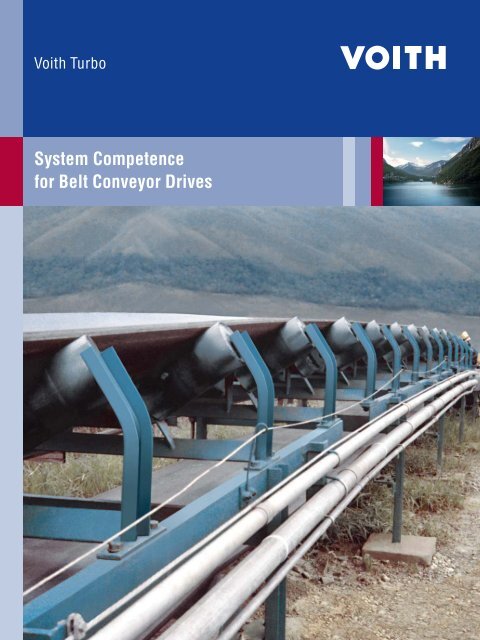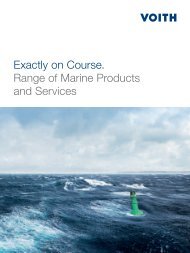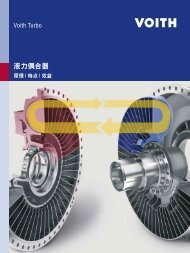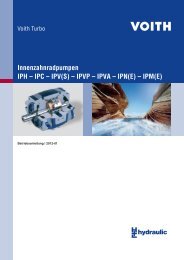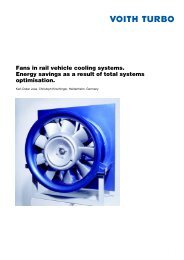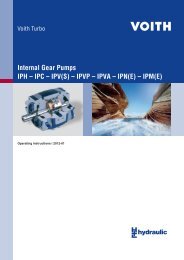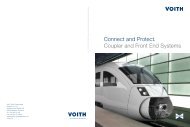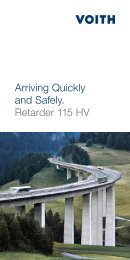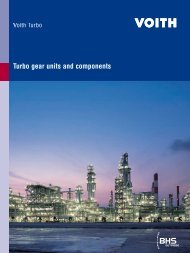System Competence for Belt Conveyor Drives - Voith Turbo
System Competence for Belt Conveyor Drives - Voith Turbo
System Competence for Belt Conveyor Drives - Voith Turbo
You also want an ePaper? Increase the reach of your titles
YUMPU automatically turns print PDFs into web optimized ePapers that Google loves.
<strong>System</strong> <strong>Competence</strong><br />
<strong>for</strong> <strong>Belt</strong> <strong>Conveyor</strong> <strong>Drives</strong>
2<br />
There are good reasons<br />
to talk with us<br />
Increasing delivery rates, longer conveyor routes,<br />
higher outputs and more stringent re quirements<br />
regarding reliability lead to ever growing demands<br />
on the drives used in modern belt conveyors.<br />
The belt is often the most expensive component<br />
and thus determines the size of the investment<br />
and the economics of the entire system. Fluid<br />
couplings from <strong>Voith</strong> (turbo couplings) protect the<br />
belt and other conveyor components and help<br />
reduce investments costs while providing maximum<br />
power transmission at the same time.<br />
When it comes to suitable solutions in this special<br />
field of drive technology, <strong>Voith</strong> <strong>Turbo</strong> is your<br />
competent partner with extensive drive system<br />
expertise. We have been manufacturing hydrodynamic<br />
couplings <strong>for</strong> belt conveyors <strong>for</strong> over<br />
50 years.<br />
More than 100,000 <strong>Voith</strong> <strong>Turbo</strong> fluid couplings<br />
are in use on belt conveyors worldwide. They<br />
have proven their value under the harshest operating<br />
conditions: under extremely challenging<br />
topography, in the cold and in the heat as well as<br />
under continually changing conditions.<br />
An ongoing dialog with research institutes, conveyor<br />
manufacturers, belt manufacturers and belt<br />
operators ensures state-of-the-art techno logy <strong>for</strong><br />
<strong>Voith</strong> products and systems compe tence <strong>for</strong> optimum<br />
interaction among all components of the<br />
belt conveyor system.
Success-oriented partnership –<br />
From the very beginning<br />
When it comes to designing modern<br />
belt conveyor systems, <strong>Voith</strong> <strong>Turbo</strong><br />
stands ready as an experienced<br />
partner.<br />
For us, system competence means:<br />
Comprehensive consultation regarding<br />
all areas of the conveyor<br />
system that are affected by the<br />
drive<br />
Supplying drive components that<br />
are perfectly suited to the operating<br />
conditions<br />
Commissioning<br />
A worldwide service network that<br />
assures you maximum system<br />
availability and profitability<br />
We will be happy to advise you regarding<br />
these points when laying<br />
out and designing the drive con cept<br />
that is best-suited <strong>for</strong> your application.<br />
Our declared goal is to always<br />
achieve the optimum cost/benefit<br />
ratio <strong>for</strong> our customers. With their<br />
worldwide presence, our subsidiaries<br />
and representatives assist in<br />
this regard by providing direct<br />
contact with you as well as fast,<br />
widely available service.<br />
3
4<br />
Your demanding specifications contain challenging<br />
requirements – <strong>Voith</strong> fluid couplings meet them!<br />
To achieve longer belt conveyors with increased per<strong>for</strong>mance,<br />
modern drives must provide higher power output. At the same<br />
time, drive units should protect the equipment and machine<br />
components, be reliable and cost-effective. A drive can meet<br />
these requirements only if it satisfies the following.<br />
Load-free motor run-up<br />
Use of low-cost squirrel cage<br />
motors requiring little maintenance<br />
Gradual build-up of start-up<br />
torque until the break-away<br />
torque of the drive is reached<br />
Limitation of the maximum torque<br />
during start-up<br />
Adapting the start-up torque to<br />
the particular load conditions<br />
Reducing longitudinal tension<br />
waves in the belt<br />
Load sharing in multi-motor<br />
drives<br />
Staggered start-up of motors in<br />
multi-motor dives in order to<br />
avoid a cumulative inrush current<br />
Simple handling and compact<br />
construction<br />
Operation characterized by minimal<br />
wear and maintenance<br />
Possible use of water as the operating<br />
fluid, especially in underground<br />
mining applications<br />
Your specifications will contain additional<br />
detailed requirements. A discussion<br />
with a <strong>Voith</strong> technical representative<br />
will show you that we<br />
can provide engineered relia bility in<br />
your drive solution. Give us the<br />
opportunity!
Tail drives<br />
It all depends on the following…<br />
Main drive<br />
When selecting the correct drive<br />
concept, more and more decisions<br />
are being made in favor of multimotor<br />
drives with lower output instead<br />
of a single higher output<br />
drive. The reasons <strong>for</strong> this include<br />
the resultant lower inrush currents<br />
as well as the ability to transmit<br />
power to several drive pulleys.<br />
<strong>Voith</strong> fluid couplings permit staggered<br />
start-up of motors in order to<br />
prevent simultaneous inrush currents.<br />
The individual motors are<br />
subjected only to the start-up torque<br />
of the <strong>Voith</strong> fluid coupling.<br />
<strong>Belt</strong><br />
Intermediate drives<br />
A natural load sharing during the<br />
start-up operation ensures that<br />
overloading of individual motors is<br />
avoided. Depending on the type and<br />
design, <strong>Voith</strong> fluid couplings offer<br />
the ability to limit the start-up torque<br />
to values between 1.1 to 1.6 of the<br />
nominal torque.<br />
Tensioning mechanism<br />
Tensioning mechanism<br />
Main drive<br />
To prevent belt slippage at the pulley,<br />
the takeup device must provide<br />
adequate pre-tension on the belt<br />
under all operating conditions. The<br />
more uni<strong>for</strong>m and gradual the acceleration,<br />
the smaller is the pretensioning<br />
<strong>for</strong>ce required.<br />
5
<strong>Belt</strong><br />
The belt is often the most expensive<br />
component of the conveyor system.<br />
Its purchase price is greater when it<br />
must transmit higher drive traction<br />
during the start-up operation. <strong>Voith</strong><br />
fluid couplings limit the torque applied<br />
and thus minimize the tension<br />
on the belt.<br />
The benefits: The belt is subject to<br />
less stretch, leading to increased<br />
service life <strong>for</strong> the belt and belt<br />
splices. In addition to use of lowercost<br />
belts, minimizing the acceleration<br />
torque means easier curve<br />
transitions <strong>for</strong> the belt.<br />
Intermediate drives<br />
Intermediate drives, such as "tripper<br />
booster" drives – distribute application<br />
of drive torque over the entire<br />
conveyor. By splitting up the drive<br />
points along the conveyor, the tension<br />
levels are significantly reduced,<br />
thus permitting use of lower-cost<br />
belts. Use of intermediate drives<br />
generally requires a suitable control<br />
mechanism, since each drive must<br />
be adjusted individually to the belt<br />
segment associated with it.<br />
Tail drives<br />
Drive stations at the tail are often a<br />
practical location <strong>for</strong> a brake, since<br />
the braking <strong>for</strong>ce acts directly on the<br />
load carrying side of the belt. The<br />
tail drive also reduces the tension<br />
on the belt in multi-drive systems. It<br />
should be possible to adjust this<br />
drive variably to the load distribution.<br />
Often, the tail drives only power the<br />
return side of the belt, in which case<br />
only the necessary power requirement<br />
is used <strong>for</strong> sizing purposes.<br />
6
7<br />
The right solution <strong>for</strong> each drive<br />
<strong>Voith</strong> <strong>Turbo</strong> satisfies the variety of requirements <strong>for</strong> drives in<br />
belt conveyor systems with a comprehensive line of couplings.<br />
Depending on the system-specific demands of the customer, the<br />
appropriate coupling is supplied <strong>for</strong> each drive and an optimum<br />
cost/benefit ratio is achieved.<br />
TV<br />
Constant-filled fluid coupling with delay chamber Constant-filled fluid coupling with enlarged delay chamber<br />
The Type TV fluid coupling with delay<br />
chamber is usually used when<br />
lower power outputs are required.<br />
During start-up, a large portion of<br />
the operating filling is retained in the<br />
attached delay chamber. As a conse<br />
quence, less torque is trans mitted<br />
during the start-up operation and<br />
the driven machine starts up under<br />
lower load. The resulting gradual,<br />
uni<strong>for</strong>m ac celeration of the belt during<br />
the course of start-up extends<br />
the service life of the belt.<br />
TVV<br />
For situations where start-up with a<br />
lower torque is necessary, use of<br />
the fluid coupling Type TVV with<br />
enlarged delay chamber can further<br />
reduce the start-up torque of the<br />
coupling and thus achieve an even<br />
more gradual acceleration of the<br />
conveyor.<br />
Even more demanding requirements<br />
on the drive are satisfied by<br />
using the Type TVVS fluid coupling<br />
with the additional annular cham ber.<br />
It produces an especially low startup<br />
torque and provides an extended<br />
torque build-up which results in an<br />
automatic adjustment to the particular<br />
load condition.
The primary design factors <strong>for</strong> a coupling are the power requirement,<br />
mass moment of inertia of the belt, and the speed of the<br />
drive motor. The coupling's size is determined from the nominal<br />
demand power and the motor speed. Depending on how the design<br />
criteria <strong>for</strong> the belt conveyor are weighted (page 4), a variety<br />
of start-up characteristics can be achieved by selecting the<br />
appropri ate coupling.<br />
TVVS<br />
Constant-filled fluid coupling with enlarged delay chamber<br />
and annular chamber<br />
Fill-controlled fluid coupling,<br />
externally supported<br />
DTPK<br />
8
With fill-controlled couplings, the<br />
degree of filling can be varied during<br />
operation. Motor run-up occurs<br />
at almost no load with a drained<br />
coupling. Fill control couplings also<br />
allow the conveyor to be accelerated<br />
precisely to follow a programmed<br />
"S-shaped" speed-time ramp. These<br />
units limit the maximum acceleration<br />
<strong>for</strong>ces and provide acti ve load<br />
sharing, tension control <strong>for</strong> booster<br />
drives, and controlled deceleration.<br />
Fill-controlled fluid coupling,<br />
self-supported<br />
M<br />
The Type DTPK is a coupling that<br />
is externally supported by motor<br />
and gearbox shaft. It is very compact<br />
in size, needs no connecting<br />
couplings and operates with almost<br />
no wear.<br />
The Type TPKL is a self-supported<br />
coupling. The concept permits simple<br />
handling and <strong>for</strong> this reason is<br />
recommended specifically <strong>for</strong> use in<br />
underground mining applications.<br />
TPKL TPKL-T<br />
Fill-controlled fluid coupling,<br />
tunnel design<br />
The Type TPKL-T is alignmentfree,<br />
as both motor and gearbox are<br />
connected to the coupling by intermediate<br />
tunnel housings. The entire<br />
drive can be attached to and detached<br />
from the drive pulley on-site<br />
without difficulty.<br />
9
<strong>Voith</strong> <strong>Turbo</strong> GmbH & Co. KG<br />
Start-up Components<br />
<strong>Voith</strong>str. 1<br />
74564 Crailsheim, Germany<br />
Tel. +49 7951 32-409<br />
Fax +49 7951 32-480<br />
startup.components@voith.com<br />
www.voithturbo.com/startup-components<br />
cr293en, aik / SVG, 04.2010, 1.500. Dimensions and drawings are given <strong>for</strong> in<strong>for</strong>mation only. Subject to modifications.


